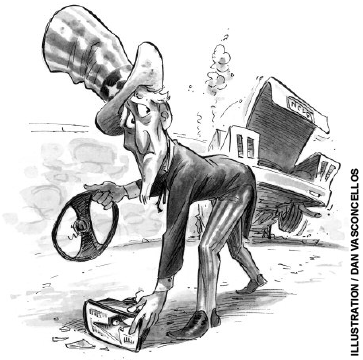Enacted in 2001, the No Child Left Behind Act (NCLB) began with the resounding promise that every U.S. schoolchild will attain “proficiency” in reading and math by 2014. Noble, yes, but also naive, misleading, and in some respects dysfunctional. While nobody doubts that the number of “proficient” students in America can and should increase dramatically from today’s woeful level, no educator believes that universal proficiency in 2014 is attainable. Only politicians promise such things. The inevitable result is weary cynicism among school practitioners and a “compliance” mentality among state and local officials.
In hindsight, NCLB’s passage was less about improving schools or fostering results-based public sector accountability than about declaring fealty to a gallant but utopian ambition, one that the statute welded to a clumsy, heavy-handed set of procedural mandates.
NCLB is, in fact, a civil rights manifesto masquerading as an education accountability system. Its grand ambition provided a shaky basis for policymaking, rather as if Congress asserted in the name of energy reform that America will no longer need to import oil after 2014 or fought crime by declaring that by that date all U.S. cities would be peaceable kingdoms.
NCLB’s particular brand of hubris has solid precedent. Picture John Kennedy pledging in 1961 that “America will get 75 percent of the way to the moon by decade’s end.” Or former President Bush and the governors solemnly declaring in 1990 that the U.S. would be 12th in the world in math and science by the year 2000. Indeed, it’s practically un-American to aim for anything less than the top.

Moreover, NCLB’s backers can legitimately argue that they had already spent nearly two decades asking state and local officials and education leaders to address mediocre school performance and stubborn race- and class-linked inequities in educational outcomes (see Figure 1). In that light, the passion-drenched unseriousness infusing NCLB is forgivable, even honorable.
And NCLB indeed has virtues: it produced long-overdue school transparency, focused unprecedented attention on achievement, created urgency where lethargy had ruled, and offers valuable political cover to determined superintendents and principals.
Kennedy’s promise was kept in just eight years, when it turned out that money, brainpower, and determination could surmount the technical challenges posed by a moon landing. The “first in the world” goal, however, was not attained and quickly became the stuff of mockery.
Invitation to a Backlash
The NCLB accountability system was adopted with scant attention to principles of sound public-sector accountability, how the statute’s many pieces fit together, or whether they could be competently deployed through the available machinery. Meanwhile, the statute’s rhetoric invites a backlash that may not only gut the law, but also discredit the increasingly fruitful goal-setting, school-changing, choice-conferring results that have marked education reform since 1983.
As the calendar rolls toward 2011 and 2012, and sharp increases in proficiency rates become necessary, the number of schools failing to make adequate progress will rise precipitously. Unless current standards are eased, thousands of schools that communities had long regarded as effective are going to be tarnished. Claims of moral urgency and vague paeans to accountability are unlikely to prove much of a match for community pride and fears for property values. Moreover, many of those schools, while doubtless less effective than they ought to be for at least some kids, are pretty decent and far better than the urban-disaster schools, where the case for mandated interventions is unarguable.
There’s nothing wrong with lofty ambitions. Yet political compromises meant that NCLB’s grand aspirations were saddled with sputtering machinery and weak sanctions. Few Americans realize that, for states to keep their Title I dollars, they need only to set goals, administer tests, report results, and see that districts intervene in specified ways in low-performing schools. NCLB doesn’t actually mandate that kids learn anything. If the kids don’t learn, or if their schools don’t improve, no sanctions follow (save possible embarrassment) so long as officials comply with the procedural requirements. The money keeps on flowing.
NCLB’s architects thought they were devising an elaborate plan to alter the behavior of thousands of schools and millions of educators, drawing on a mix of goals, rewards, sanctions, choices, and sunlight. They overlooked the fact that effective behavior-changing regimens are rooted in realistic expectations and joined to palpable incentives and punishments; NCLB provides none of these.
Aspirational Politics
The conventional account, as told by NCLB champions like Congressman George Miller, Senator Ted Kennedy, Secretary of Education Margaret Spellings, or advocates like the Education Trust or Citizens’ Commission on Civil Rights, is that the law capped a 12-year effort to advance education accountability from Washington. They attribute any apparent failures to implementation glitches, foot dragging by state and local officials, educator recalcitrance, or lack of funding.
In this telling, 1989’s Charlottesville summit begat Bush’s America 2000 plan, which begat conjoined twins—Clinton’s Goals 2000 plan and Improving America’s Schools Act (IASA)—which somehow begat NCLB, with each generation better able than its ancestors to drive education reform and boost student achievement.
That chronology is right, but the record of steady progress forward is questionable. An evolution of sorts did take place, with Uncle Sam’s hand pressing down harder and harder and with ever more elaborate provisions meant to keep states, districts, and schools in line. Several pending reauthorization proposals—notably those from the Aspen commission chaired by former governors Tommy Thompson and Roy Barnes—would extend that pattern and press down harder still from Washington, with more rules, regulations, and commands.
That may well be what Congress ends up doing. But it is unlikely to work as intended, because it misdiagnoses the essential problem.
In promoting education reform during the 2000 campaign and after, President Bush fatefully chose to focus on compassionate moralism (e.g., “the soft bigotry of low expectations”) rather than on reshaping the structures and incentives of K–12 schooling. In so doing, he reflected standard Washington practice: the rhetoric of education policy is more often about social justice than about incentives or instruction. Enlisting allies in the civil rights community who were eager to see improved outcomes for poor and minority students, Bush was able to forge a bipartisan coalition stronger than the status quo defeatism of the National Education Association.
What is remarkable is that, at the very moment of supposed conservative “victory” on federal education policy, the Bush administration embraced a moralistic conception of accountability and big-government enforcement rather than the pragmatic, incentive-focused model that had emerged from three decades of conservative critiques of grandiose Great Society designs.
It’s a mistake to depict NCLB either as perfecting its statutory predecessors or as a coherent engine of behavior modification. NCLB’s provisions are a hodgepodge of Texas precedents, “New Democrat” reforms, liberal nostrums, and proposals by countless constituencies, all superimposed on programmatic architecture and rules that had accumulated since Lyndon Johnson worked in the Oval Office.
Many Prototypes
Embedded within NCLB’s accountability system are three distinct, discernible models of educational change that have been awkwardly welded together.
Model one would make transparent the performance of students across the nation, providing an X-ray to show parents, educators, and policymakers how different schools and groups are performing in key subjects. Model two would deploy “behavior modification” accountability methods, refined through decades of public sector reform, to force low-performing schools and districts to set goals, assess effectiveness, and do better. And model three would set “shoot-the-moon” targets and use the federal bully pulpit to exhort leaders in states and districts to improve.
Each of these approaches is plausible on its own terms. And each has a place in federal policy. But they cannot reasonably be linked to one another, as NCLB tries to do. They entail discrepant views of the federal role in education and employ discordant mechanisms. The result isn’t working.
For example:
—The value of an “X-ray” of the nation’s school performance has long been recognized. NCLB’s dictate that all states regularly test students in key subjects marked a historic success. The accuracy of the picture is compromised, however, when this cross-sectional look at student achievement becomes the basis for gauging the performance of schools and educators, much less for triggering interventions or remedies. We don’t judge doctors based on whether their patients are sick today but by how much patient health improves under their care. Judging professional performance on the basis of a one-moment-in-time X-ray encourages questionable behavior, leads states to play games with standards, and threatens to discredit the X-ray itself.
—Prodding public sector institutions to set goals, monitor performance, and then reward excellence and address mediocrity has been a signal success for reformers on both the left and the right. Decades of studied effort, touted in iconic books like Reinventing Government and championed through the 1990s by the Gore commission, make clear that sensibly structured accountability systems encourage self-interested workers to take goals seriously, focus on outcomes, and employ all the levers at their disposal to produce those outcomes. But we compromise such “behavior modification” when those on the ground view the targets as unattainable. If workers know they are unlikely to succeed, the goal becomes to avoid trouble when they fail. By making failure inevitable, unrealistic goals have the perverse effect of focusing employees on compliance and encouraging actions that will mask “failure.”
—Bully pulpit exhortation is a legitimate role for federal officials. Dating at least to Bill Bennett’s colorful tenure as secretary, the Department of Education has sometimes been a valuable podium from which to promote and energize school reform. Setting high bars and challenging state and local officials to meet them provides political cover to leaders, while lighting fires under laggards. It’s great to shine a bright light on performance and then laud or shame schools, states, and districts based on that performance. Yet such efforts are discredited when they are based on X-rays ill-equipped to readily trace progress or when behavior modification schemes lead local officials and educators to react by devoting their energies to bureaucratic compliance on the one hand, and loophole exploitation on the other.
Rube Goldberg structures are generally unstable as well as unattractive, and the stability of this one is further menaced by the cracking foundation under it: education federalism circa 1965. NCLB’s architects failed to appreciate how weakly that foundation supported even the lighter burdens of Goals 2000 and IASA, both passed in 1994. Those measures had taken for granted that the LBJ-era mechanisms for distributing federal dollars allocated for needy children via state and local education agencies were also suited to a regimen of school reform.
That hierarchy of responsibility—from Washington to state education department to local school system to school and finally to classroom—has been the basis of federal education policy since passage of the Elementary and Secondary Education Act. But it was never designed to support a results-based accountability system; repair schools or districts; function in an environment awash in charter schools, home schooling, and distance learning; or address the dysfunctions of the very agencies charged with its implementation.
Although IASA and Goals 2000 were not nearly as demanding as NCLB, close listeners could already hear the foundation cracking. Yet to our knowledge, none of NCLB’s architects even paused to ask whether a hierarchy decently suited to distribute money via certain formulas could manage a very different and much more aggressive federal role or the exigencies of school improvement. To accomplish these tasks competently, the federal government would require much more direct authority over resources, assessments, low-performing schools, and interventions. By no means are we endorsing efforts to give the feds that kind of control. We are, however, noting that operating in a federal system without such grand powers requires that federal officials legislate and act with an eye to what they can and cannot constructively do. The seeming nonchalance with which NCLB’s proponents tossed new responsibilities onto this precarious governmental base betrayed a dangerous unconcern.
Bundling together the X-ray assessment, behavior modification, and aspirational jawboning also presumes that federal intervention on all three counts was and is appropriate everywhere in the land. Not true, and another challenge to traditional notions of education federalism. In fact, several states, including Florida and Massachusetts, already had X-ray assessment or behavior modification systems more advanced than those required by NCLB. Moreover, the fact that these systems were not linked to a fixed date for universal proficiency was arguably a strength, not a problem.
What to Do
Can this law be saved? Yes, indeed, but only if we thoughtfully separate its key components from one another and from naively heroic expectations.
It is appropriate for Uncle Sam to demand that every state provide a fine-grained image of student achievement. It’s reasonable also to insist that states develop sanctions, remedies, and interventions for schools and districts that are performing badly and not improving. Washington should indeed press states to track performance levels, but “adequate progress” should be based primarily on the academic value that schools add (i.e., the achievement gains their pupils make), not merely on the aggregate level at which students perform.
Moreover, states that are already moving on these fronts do not need federal intervention, much less cookie-cutter prescriptions. It’s folly for Congress to draft school-level modifications; far better to require that lagging states act, then move to withhold funds—big bucks, including, if necessary, the whole Title I payment—from any that sit on their hands or post unacceptable results.
It’s valuable, too, for Washington to set ambitious goals and exhort everyone to attain them. But the constructive way to do this is by promoting transparency, setting benchmarks, rewarding high achievers, pointing fingers at laggards, and clearing political obstacles. With a consistent metric, call it a national standard, accompanied by national tests, everyone’s performance can be fairly tracked and compared. If the Jefferson School lags behind the Franklin School; if Hispanic youngsters in Tucson fall behind Hispanic pupils in San Antonio; if Springfield can’t keep pace with Sacramento; if Ohio is making gains but Kentucky isn’t, all these and more should be readily visible. Comparisons should be easy and swift. Washington can competently see to this. But it cannot competently micromanage what state, districts, or schools do. And it shouldn’t try.
Even the Great Society’s most daring and important victories avoided the sweeping hubris of NCLB. Neither the Civil Rights Act of 1964 nor the Voting Rights Act of 1965, both remembered now as towering triumphs, ever sought to change precinct-level behaviors. Backed by the National Guard and armed with clear, concrete, and fairly straightforward goals, federal officials focused entirely on forcing a limited number of recalcitrant states to adopt specific changes. This is the kind of role in which federal leadership has a reasonable record of success.
That accomplishment can happen in education, too, if we couple an emphasis on readily comparable gauges of performance and progress with real consequences for mediocrity and inertia.
NCLB could have a bright future, if it gets an extreme makeover.
Frederick M. Hess is director of education policy studies at the American Enterprise Institute (AEI). Chester E. Finn Jr. is president of the Thomas B. Fordham Foundation and senior fellow at Stanford’s Hoover Institution. They are coeditors of the new book, No Remedy Left Behind: Lessons from a Half-Decade of NCLB, from AEI Press.





